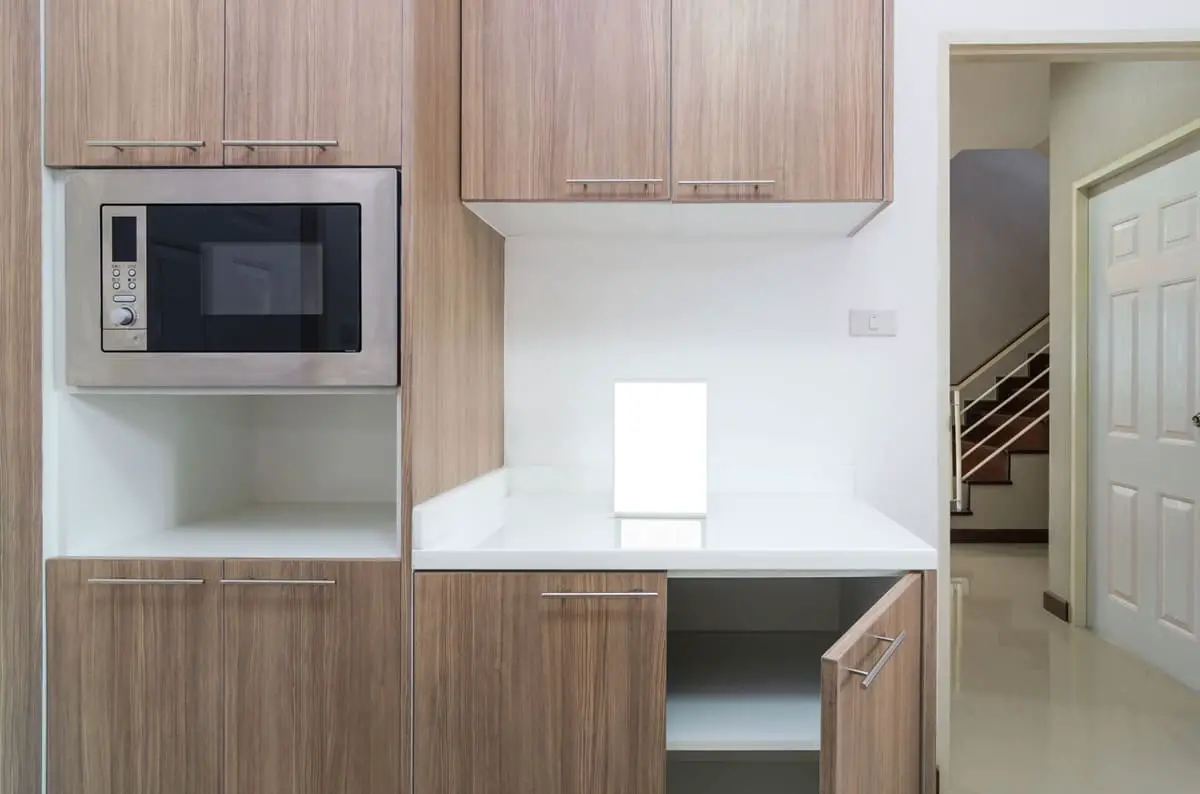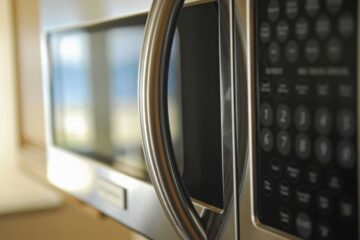Microwaves have become an indispensable kitchen appliance, and their placement can have a significant impact on both functionality and aesthetics. Finding the ideal placement for your microwave requires careful consideration of various factors, including the size and type of microwave, the size of your cabinets, and your kitchen layout. In this article, we’ll explore how far your microwave should stick out from cabinets, and offer expert tips on achieving optimal placement.
The Ideal Microwave Placement
The recommended distance from the cabinets
The ideal placement of your microwave depends on several factors, including the recommended distance from the cabinets. As a general rule, your microwave should not extend more than an inch or two beyond the edge of the cabinets. This ensures that the microwave remains easily accessible and does not interfere with any other appliances or features in your kitchen.
The perfect height
The ideal height for your microwave depends on the type of microwave and the user’s height. Generally, a countertop microwave should be placed at a height that is easily reachable, while an over-the-range microwave should be placed at a height that allows for easy access to the range below.
Factors that Affect Microwave Placement
The size of your microwave
The size of your microwave is an essential factor that affects its placement. A larger microwave may require a more significant distance from the cabinets, while a smaller microwave may allow for a closer placement.
The size of your cabinets
The size of your cabinets is another essential factor that affects microwave placement. Larger cabinets may require a larger microwave, while smaller cabinets may only allow for a smaller microwave.
The type of microwave
The type of microwave you have will also determine its ideal placement. Over-the-range microwaves require a different placement than countertop microwaves.
Your kitchen layout
Your kitchen layout is also an important consideration. Your microwave placement should be such that it does not interfere with the overall flow of your kitchen.
Microwave Placement for Over-the-Range Microwaves
The ideal distance between the stove and microwave
For over-the-range microwaves, the ideal distance between the stove and microwave is typically between 13 and 16 inches. This ensures that the microwave is easily accessible and does not interfere with the range below.
The recommended height for over-the-range microwaves
The recommended height for over-the-range microwaves is typically between 15 and 18 inches above the stove. This height allows for easy access to the microwave and allows for adequate ventilation.
Microwave Placement for Countertop Microwaves
The recommended distance from the wall
For countertop microwaves, the recommended distance from the wall is typically between 2 and 4 inches. This ensures that the microwave remains stable and does not interfere with any other appliances or features in your kitchen.
The ideal height for countertop microwaves
The ideal height for countertop microwaves is typically between 3 and 5 inches above the countertop. This height allows for easy access to the microwave and ensures that it remains stable and secure.
How to Measure the Correct Height?
Steps to measure the height
To measure the correct height for your microwave, first, measure the distance from the floor to the bottom of your cabinets. Next, subtract the height of your microwave from this measurement. This will give you the ideal height for your microwave.
Tools required for measuring
To measure the height of your microwave, you will need a tape measure, a level, and a pencil. These tools will allow you to accurately measure and mark the ideal height for your microwave.
Installing a Microwave Shelf
A microwave shelf can provide additional storage space and create a more streamlined look in your kitchen. If you choose to install a microwave shelf, it is important to consider the ideal height for both safety and convenience.
Reasons to install a microwave shelf:
- Saves countertop space: A microwave shelf can free up valuable counter space, making your kitchen feel less cluttered.
- Convenience: Placing your microwave at eye level can make it easier to use and reduce the risk of spills or burns.
- Improved accessibility: A microwave shelf can be a good solution for those with mobility issues, making it easier to reach and use the microwave.
- Customizable: A microwave shelf can be customized to fit your kitchen’s design and aesthetic.
The ideal height for the shelf:
- The ideal height for a microwave shelf is around 15 inches above the countertop.
- This height provides easy access and reduces the risk of spills or burns.
- Be sure to measure the height of your microwave before installing the shelf to ensure it will fit comfortably.
How to install a microwave shelf:
- Find a location: Determine the best location for your microwave shelf, taking into consideration the distance from other appliances and the user’s height.
- Measure and cut the shelf: Measure the length and width of the microwave and cut the shelf accordingly.
- Install brackets: Install the brackets for the shelf, ensuring they are level and secure.
- Attach the shelf: Attach the shelf to the brackets, ensuring it is level and secure.
- Install the microwave: Place the microwave on the shelf and ensure it is stable and secure.
Safety Considerations
When it comes to microwave placement, safety should be a top priority. Here are some safety considerations to keep in mind:
Electrical safety:
- Make sure the electrical outlet is properly grounded and has the correct voltage and amperage for your microwave.
- Don’t overload the circuit by plugging too many appliances into the same outlet.
Proper ventilation:
- Make sure your microwave has adequate ventilation to prevent overheating and potential fire hazards.
- Follow the manufacturer’s recommendations for ventilation requirements and keep the vents clean and free of obstructions.
Fire safety:
- Avoid placing flammable materials such as paper or plastic near the microwave.
- Keep the area around the microwave clean and free of grease or food particles.
Tips for Microwave Placement
Here are some additional tips for properly placing your microwave:
- Avoiding interference with other appliances: Keep your microwave away from other appliances to prevent interference and ensure they are functioning properly.
- Considering the user’s height and accessibility: When deciding on the height and placement of your microwave, consider who will be using it and their height and accessibility needs.
- Keeping the microwave clean: Regularly clean the microwave to prevent buildup of food particles or grease.
Microwave Placement and Design
When choosing a microwave placement, it is important to consider how it will fit into the overall design of your kitchen. Here are some tips for incorporating your microwave into your kitchen’s design:
- Matching the microwave with the kitchen design: Choose a microwave that matches the design and aesthetic of your kitchen.
- Incorporating the microwave into custom cabinetry: Consider incorporating the microwave into custom cabinetry to create a seamless and streamlined look.
Alternatives to Traditional Microwave Placement
If you don’t want to place your microwave on the countertop or above the stove, there are alternative placement options to consider:
Drawer microwaves:
- Drawer microwaves are installed in a lower cabinet and can be easily accessed by pulling out the drawer.
- This placement allows for easy access without taking up valuable counter or cabinet space.
Under-cabinet microwaves:
An under-cabinet microwave is mounted beneath a cabinet or shelf, providing a space-saving alternative to traditional microwave placement. These microwaves are typically smaller and designed for countertop use, making them a great option for kitchens with limited space.
The installation process for under-cabinet microwaves is similar to that of over-the-range microwaves. However, there are some key differences to keep in mind. For example, the height and distance from the stove are less of a concern since the microwave is mounted underneath a cabinet.
When considering an under-cabinet microwave, it’s important to measure the space where the microwave will be installed to ensure that it will fit properly. Additionally, you will need to make sure that the cabinet or shelf is sturdy enough to support the weight of the microwave.
Microwave Drawers:
Microwave drawers are another alternative to traditional microwave placement. These microwaves are installed into a cabinet or island, with the door of the microwave sliding out like a drawer. Microwave drawers are a great option for those who want to keep their microwave out of sight, as they can be easily integrated into the kitchen design.
When installing a microwave drawer, it’s important to consider the size of the drawer and the space where it will be installed. Additionally, you will need to make sure that the drawer is properly installed and secured to prevent any accidents.
Common Microwave Placement Mistakes
While there are many tips and guidelines to follow for proper microwave placement, it’s also important to be aware of common placement mistakes to avoid. Here are a few things to keep in mind:
- Placing the microwave too high: If the microwave is mounted too high, it can be difficult to reach and use. This can be especially problematic for shorter individuals or those with mobility issues.
- Placing the microwave too low: On the other hand, if the microwave is mounted too low, it can be a safety hazard. If it’s too close to the ground, it can be easily bumped or knocked over, potentially causing injury or damage to the appliance.
- Placing the microwave too close to the stove: If the microwave is mounted too close to the stove, it can be a fire hazard. This is especially true for over-the-range microwaves, which are located directly above the stove.
Conclusion
Proper microwave placement is important for both functionality and safety. By following the guidelines outlined in this article, you can ensure that your microwave is placed in an ideal location that works best for your kitchen layout and design.
Remember to consider the size of your microwave, cabinets, and kitchen layout when deciding on placement. It’s also important to keep safety considerations in mind, such as proper ventilation and electrical safety.
By taking the time to measure and plan for proper microwave placement, you can enjoy the convenience of your microwave without sacrificing style or safety.



